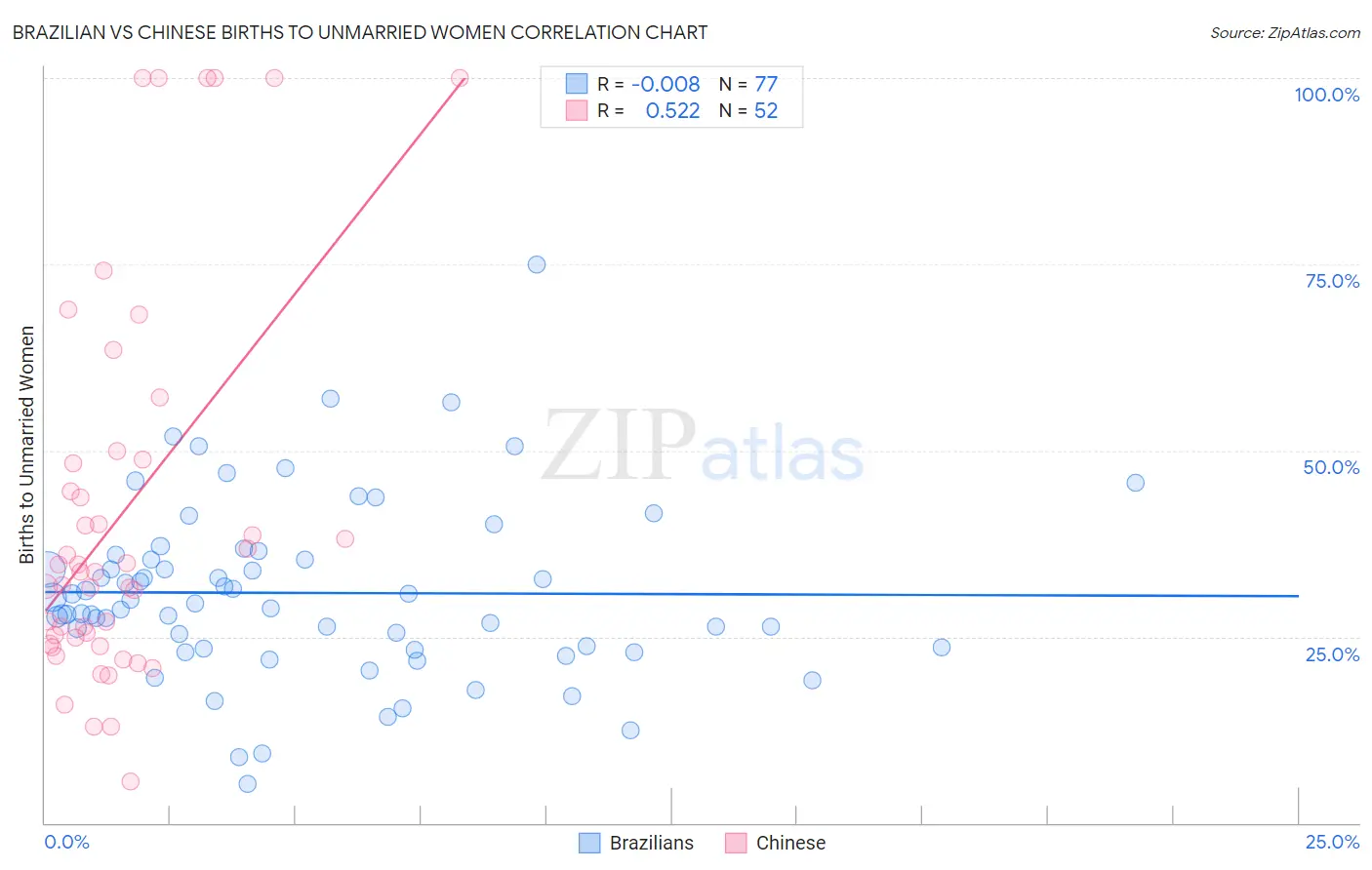Brazilian vs Chinese Births to Unmarried Women
COMPARE
Brazilian
Chinese
Births to Unmarried Women
Births to Unmarried Women Comparison
Brazilians
Chinese
30.4%
BIRTHS TO UNMARRIED WOMEN
84.8/ 100
METRIC RATING
135th/ 347
METRIC RANK
30.2%
BIRTHS TO UNMARRIED WOMEN
87.1/ 100
METRIC RATING
127th/ 347
METRIC RANK
Brazilian vs Chinese Births to Unmarried Women Correlation Chart
The statistical analysis conducted on geographies consisting of 304,585,920 people shows no correlation between the proportion of Brazilians and percentage of births to unmarried women in the United States with a correlation coefficient (R) of -0.008 and weighted average of 30.4%. Similarly, the statistical analysis conducted on geographies consisting of 63,513,648 people shows a substantial positive correlation between the proportion of Chinese and percentage of births to unmarried women in the United States with a correlation coefficient (R) of 0.522 and weighted average of 30.2%, a difference of 0.47%.

Births to Unmarried Women Correlation Summary
| Measurement | Brazilian | Chinese |
| Minimum | 5.3% | 5.5% |
| Maximum | 74.9% | 100.0% |
| Range | 69.6% | 94.5% |
| Mean | 30.9% | 41.4% |
| Median | 29.4% | 33.7% |
| Interquartile 25% (IQ1) | 23.4% | 24.5% |
| Interquartile 75% (IQ3) | 35.7% | 48.5% |
| Interquartile Range (IQR) | 12.3% | 24.0% |
| Standard Deviation (Sample) | 11.8% | 25.6% |
| Standard Deviation (Population) | 11.7% | 25.4% |
Demographics Similar to Brazilians and Chinese by Births to Unmarried Women
In terms of births to unmarried women, the demographic groups most similar to Brazilians are Immigrants from Scotland (30.4%, a difference of 0.030%), Immigrants from South Eastern Asia (30.4%, a difference of 0.070%), Immigrants from Morocco (30.4%, a difference of 0.080%), New Zealander (30.3%, a difference of 0.13%), and Immigrants from Zimbabwe (30.3%, a difference of 0.16%). Similarly, the demographic groups most similar to Chinese are European (30.2%, a difference of 0.030%), Vietnamese (30.2%, a difference of 0.14%), Croatian (30.2%, a difference of 0.22%), Icelander (30.3%, a difference of 0.24%), and Syrian (30.2%, a difference of 0.25%).
| Demographics | Rating | Rank | Births to Unmarried Women |
| Koreans | 88.9 /100 | #121 | Excellent 30.1% |
| Immigrants | Argentina | 88.7 /100 | #122 | Excellent 30.1% |
| Syrians | 88.2 /100 | #123 | Excellent 30.2% |
| Croatians | 88.0 /100 | #124 | Excellent 30.2% |
| Vietnamese | 87.7 /100 | #125 | Excellent 30.2% |
| Europeans | 87.2 /100 | #126 | Excellent 30.2% |
| Chinese | 87.1 /100 | #127 | Excellent 30.2% |
| Icelanders | 86.0 /100 | #128 | Excellent 30.3% |
| Immigrants | Spain | 85.8 /100 | #129 | Excellent 30.3% |
| Immigrants | Bosnia and Herzegovina | 85.7 /100 | #130 | Excellent 30.3% |
| Immigrants | Zimbabwe | 85.7 /100 | #131 | Excellent 30.3% |
| New Zealanders | 85.5 /100 | #132 | Excellent 30.3% |
| Immigrants | Morocco | 85.2 /100 | #133 | Excellent 30.4% |
| Immigrants | South Eastern Asia | 85.2 /100 | #134 | Excellent 30.4% |
| Brazilians | 84.8 /100 | #135 | Excellent 30.4% |
| Immigrants | Scotland | 84.6 /100 | #136 | Excellent 30.4% |
| Immigrants | Philippines | 83.9 /100 | #137 | Excellent 30.4% |
| Puget Sound Salish | 83.9 /100 | #138 | Excellent 30.4% |
| Immigrants | Canada | 83.7 /100 | #139 | Excellent 30.4% |
| Swiss | 83.1 /100 | #140 | Excellent 30.5% |
| Pakistanis | 83.0 /100 | #141 | Excellent 30.5% |